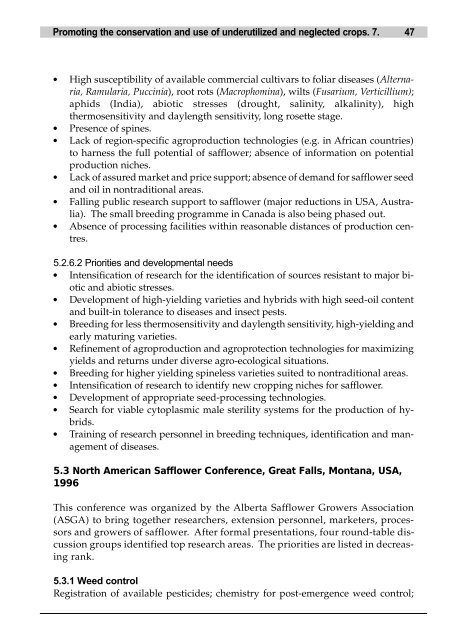Safflower, Carthamus tinctorius L. - Bioversity International
Safflower, Carthamus tinctorius L. - Bioversity International
Safflower, Carthamus tinctorius L. - Bioversity International
You also want an ePaper? Increase the reach of your titles
YUMPU automatically turns print PDFs into web optimized ePapers that Google loves.
Promoting the conservation and use of underutilized and neglected crops. 7.<br />
● High susceptibility of available commercial cultivars to foliar diseases (Alternaria,<br />
Ramularia, Puccinia), root rots (Macrophomina), wilts (Fusarium, Verticillium);<br />
aphids (India), abiotic stresses (drought, salinity, alkalinity), high<br />
thermosensitivity and daylength sensitivity, long rosette stage.<br />
● Presence of spines.<br />
● Lack of region-specific agroproduction technologies (e.g. in African countries)<br />
to harness the full potential of safflower; absence of information on potential<br />
production niches.<br />
● Lack of assured market and price support; absence of demand for safflower seed<br />
and oil in nontraditional areas.<br />
● Falling public research support to safflower (major reductions in USA, Australia).<br />
The small breeding programme in Canada is also being phased out.<br />
● Absence of processing facilities within reasonable distances of production cen-<br />
tres.<br />
5.2.6.2 Priorities and developmental needs<br />
● Intensification of research for the identification of sources resistant to major biotic<br />
and abiotic stresses.<br />
● Development of high-yielding varieties and hybrids with high seed-oil content<br />
and built-in tolerance to diseases and insect pests.<br />
● Breeding for less thermosensitivity and daylength sensitivity, high-yielding and<br />
early maturing varieties.<br />
● Refinement of agroproduction and agroprotection technologies for maximizing<br />
yields and returns under diverse agro-ecological situations.<br />
● Breeding for higher yielding spineless varieties suited to nontraditional areas.<br />
● Intensification of research to identify new cropping niches for safflower.<br />
● Development of appropriate seed-processing technologies.<br />
● Search for viable cytoplasmic male sterility systems for the production of hy-<br />
brids.<br />
● Training of research personnel in breeding techniques, identification and management<br />
of diseases.<br />
5.3 North American <strong>Safflower</strong> Conference, Great Falls, Montana, USA,<br />
1996<br />
This conference was organized by the Alberta <strong>Safflower</strong> Growers Association<br />
(ASGA) to bring together researchers, extension personnel, marketers, processors<br />
and growers of safflower. After formal presentations, four round-table discussion<br />
groups identified top research areas. The priorities are listed in decreasing<br />
rank.<br />
5.3.1 Weed control<br />
Registration of available pesticides; chemistry for post-emergence weed control;<br />
47

















